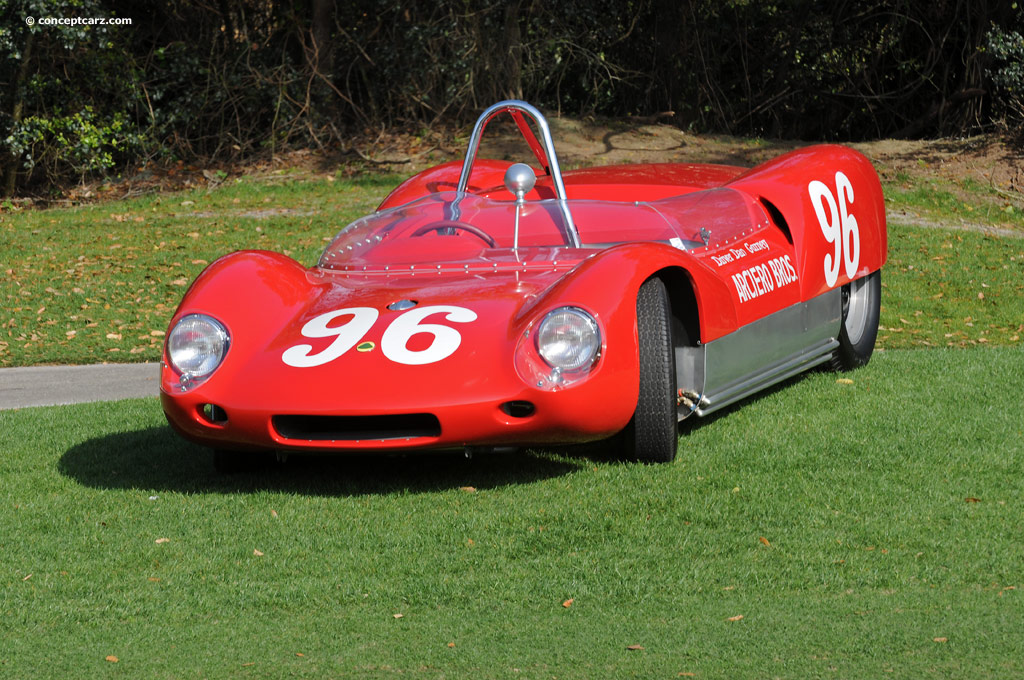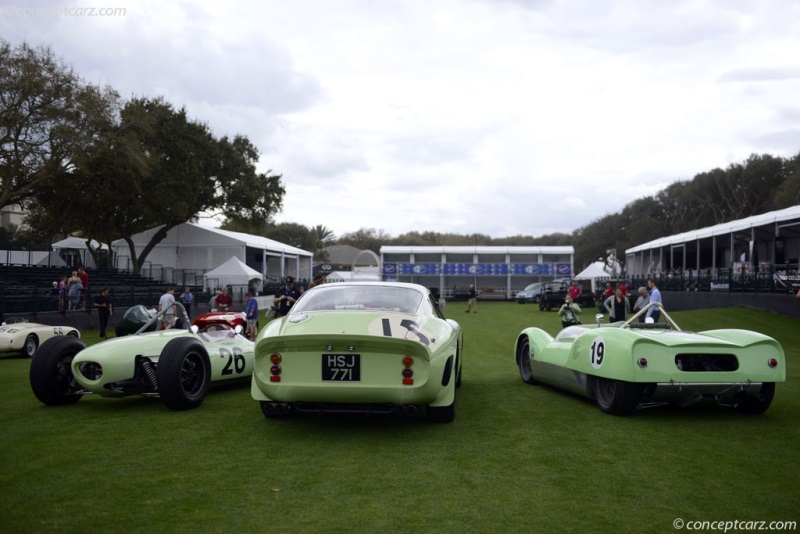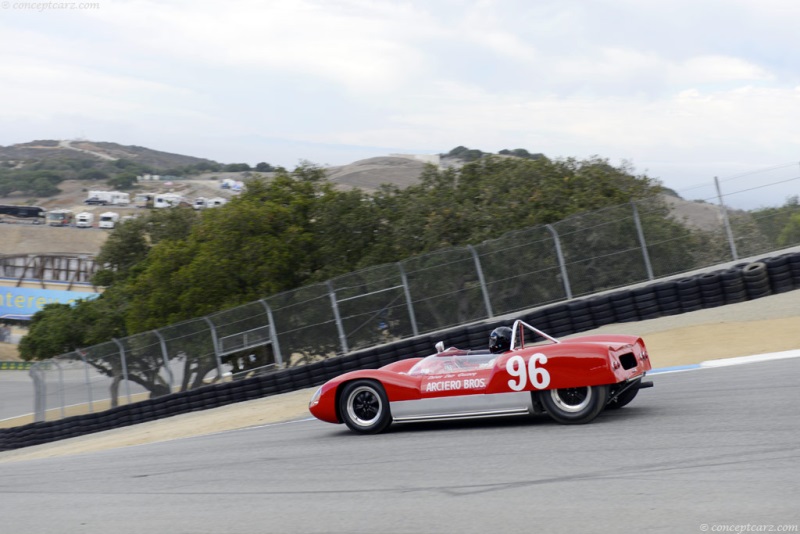1960 Lotus Type 19 Navigation
History
In 1959, Lotus introduced their mid-engine Type 18 single seat racing car. It was designed to compete in Formula Junior, Formula Two, and Formula One. It was the company's first mid-engine car built and was a vast improvement over Chapman's early front-engined formula cars. The following year, they introduced the Type 19 sports racer. Both of these cars would help propel the Lotus marque to a new level of competition and served as a replacement to the company's range of front engined racers.
The single seater chassis was enlarged to accommodate a second seat, resulting in the Type 19. The chassis was a conventional steel multi-tubular spaceframe setup suspended by double wishbones with coil springs in the front and reversed lower wishbones with a radius arm in the rear. Powering the original Type 19 was a Coventry Climax FPF four-cylinder engine with an aluminum block and head. It produced nearly 2.5 liters and produced roughly 240 horsepower. The five-speed sequential gearbox was bolted directly onto the engine allowing for quick ratio changes. At all four-corners were Girling disc brakes.
The sleek bodywork was comprised of glass-fiber reinforced plastic and aluminum. It had a similar design to the Cooper T49 'Monaco', earning it the nickname 'Monte Carlo.' Another reason for its name was in honor of Stirling Moss's victory at the 1960 Monaco Grand Prix.
The first driver to test the Type 19 was Stirling Moss. He drove the new car to a sports car lap record at Silverstone. A short time later, Moss drove the Type 19 at its competition debut at Karlskoga in Sweden, where he emerged victorious. Joakim Bonnier drove the prototype car to a Swedish record for the flying kilometer, achieving a speed of 253 km/h.
For the 1961 season, twelve Type 19 cars were prepared for competition. The results of the 1960 season made it very popular, and possibly more examples may have been produced if there was not a shortage of FPF engines. Most of the cars created were sent to the United States.
Dan Gurney enjoyed much success with his Type 19, often outpacing other more powerful machines. In early 1962, he was victorious at the Daytona 3 Hours while driving the Arciero Brothers Lotus 19. This was one of his most memorable victories, as he crossed the line with a seized engine.
Between 1960 - 1960, Lotus produced 17 examples of the Type 19, and one example of the 19B. It was not uncommon for the four-cylinder engine to be replaced by a much larger and more powerful V8 engine. The last Type 19 example to be built was designed specifically to house Ford's small block V8. Thus, it was given the name '19B,' also known as the 'Pacesetter Special.' In the hands of Dan Gurney, it enjoyed some success.
It took a few years before Lotus built a sports car replacement. In 1964, the introduced the Type 30. This would be Chapman's first and only attempt to compete in the newly formed Can Am (Group Seven) racing.
By Daniel Vaughan | Jul 2011
The single seater chassis was enlarged to accommodate a second seat, resulting in the Type 19. The chassis was a conventional steel multi-tubular spaceframe setup suspended by double wishbones with coil springs in the front and reversed lower wishbones with a radius arm in the rear. Powering the original Type 19 was a Coventry Climax FPF four-cylinder engine with an aluminum block and head. It produced nearly 2.5 liters and produced roughly 240 horsepower. The five-speed sequential gearbox was bolted directly onto the engine allowing for quick ratio changes. At all four-corners were Girling disc brakes.
The sleek bodywork was comprised of glass-fiber reinforced plastic and aluminum. It had a similar design to the Cooper T49 'Monaco', earning it the nickname 'Monte Carlo.' Another reason for its name was in honor of Stirling Moss's victory at the 1960 Monaco Grand Prix.
The first driver to test the Type 19 was Stirling Moss. He drove the new car to a sports car lap record at Silverstone. A short time later, Moss drove the Type 19 at its competition debut at Karlskoga in Sweden, where he emerged victorious. Joakim Bonnier drove the prototype car to a Swedish record for the flying kilometer, achieving a speed of 253 km/h.
For the 1961 season, twelve Type 19 cars were prepared for competition. The results of the 1960 season made it very popular, and possibly more examples may have been produced if there was not a shortage of FPF engines. Most of the cars created were sent to the United States.
Dan Gurney enjoyed much success with his Type 19, often outpacing other more powerful machines. In early 1962, he was victorious at the Daytona 3 Hours while driving the Arciero Brothers Lotus 19. This was one of his most memorable victories, as he crossed the line with a seized engine.
Between 1960 - 1960, Lotus produced 17 examples of the Type 19, and one example of the 19B. It was not uncommon for the four-cylinder engine to be replaced by a much larger and more powerful V8 engine. The last Type 19 example to be built was designed specifically to house Ford's small block V8. Thus, it was given the name '19B,' also known as the 'Pacesetter Special.' In the hands of Dan Gurney, it enjoyed some success.
It took a few years before Lotus built a sports car replacement. In 1964, the introduced the Type 30. This would be Chapman's first and only attempt to compete in the newly formed Can Am (Group Seven) racing.
By Daniel Vaughan | Jul 2011
- 1960 Lotus Type 19 Menu
- Article
- Image gallery
- Valuation
- Specifications
- Profiles
1960 Lotus Type 19 Vehicle Profiles
Recent Vehicle Additions
Related Automotive News

JOHN SURTEES CBE ANNOUNCES AUCTION LOTS FOR THE 2016 HENRY SURTEES FOUNDATION TEAM KARTING CHALLENGE
Tuesday 5 July 2016 – Mercedes-Benz World Circuit, Brooklands
Team entries are shaping up well for the hotly contested Henry Surtees Foundation Team Karting Challenge, which will take place on Tuesday 5 July 2016. The event organised by John S...
Scuderia Ugolini: 1959 Formula One Season
While the name Ferrari is recognized the world-over, Ugolini, on the other hand, is only a name recognized by those very knowledgeable of motor racing and football. However, the name is nearly as vitally important to the world of motor sport. In 1959,...

1959 German Grand Prix: Briton-Italian Dominance Amidst the Darkness
In the pages of Formula One history, the weekend of the 1959 German Grand Prix is usually remembered for a couple of incidents. One of those would see a providential escape. The other, unfortunately, would end in tragedy. Most unfortunate is the fact...

1965 Mexico Grand Prix: Ginther Finally Gets It!
Richie Ginther had come so close so many times in the past but had always been outshone by someone else for victory. Now with the new Honda Team, it seemed anybody other than Ginther would win. But all of that would change on the 24th of October, 1965.
Ginthers...

1962 Monaco Grand Prix: McLaren Carries the Cooper Flag back to the Top
By the beginning of the 1962 Formula One season Jack Brabham had left Cooper to form his own racing team. It seemed the glories days of the double World Championship were well and truly behind them. However, left in Brabhams stead would be a man very...


























